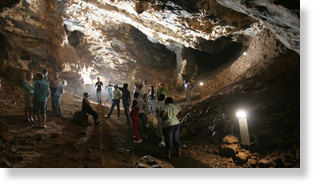
Archeologists studied teeth from 19 sets of prehistoric early human remains found in two caves in South Africa's Sterkfontein Valley.
The researchers, whose work was published in the journal Nature, were able to surmise that the females grew up in a different area from where they died, while the men appeared to be local.
Julia Lee-Thorp, co-author of the study, told CTV.ca the research helps provide a rare glimpse into the way human ancestors lived their lives.
"It's exciting because it's the first real hard evidence we have of an ancient social pattern, so it begins to give us much better clues about how they constructed their family groups than we had before," said Lee-Thorp, reached by phone at Oxford University in the U.K., where she is an archeological scientist.
Of the 19 teeth that were analyzed, 90 per cent of the male teeth were from adults who originated from the area where they died.
By comparison, less than half of the smaller teeth, which were presumed to be female, looked local.
Lee-Thorpe and her team analyzed the chemical composition of the teeth in order to track their origin.
The remains -- which are believed to be the leftovers from hunting expeditions by sabre-tooth tigers and hyenas -- are believed to be between 1.8 and 2.2 million years old.
The area where the fossils were found was ideal for the archeologists' purposes, because it consists of diverse geological bands each with a unique level of the element strontium in the soil. Lee-Thorp described it as a geographical "signature."
That strontium signature is transferred from the soil to plants that grow locally, and then on to the creatures that feed on those plants -- in this case early human ancestors.
As a result, Lee-Thorp and her team were able to identify the 'home towns' of their subjects by testing the teeth for strontium isotope levels, then matching it to the soil content of a specific area. They tested the canine tooth and third molar -- teeth which are formed by about the age of eight.
While the study provides tantalizing hints about early human behaviour, Lee-Thorp said few conclusions can be drawn about the lifestyles of those who walked the Earth millions of years ago.
The question of why the women left home, for example, is a difficult one to answer.
From an evolutionary perspective it's likely they left their clan as they reached maturity, in order to mate while avoiding inbreeding.
But whether they were taken by marauding courters, or simply felt the call of nature and ventured into the wild in search of a new gene pool, will likely never be known, Lee-Thorp said.
However there are relevant behavioural patterns that can be observed today in the family groups and social patterns of chimpanzees and gorillas.
Lee-Thorp said chimp groupings tend to consist of multiple families and include a number of males and females. But there are examples of males either abducting females, or strongly encouraging them to join a new troupe.
In gorilla groups, because only one adult male is present at a time, young females and males must both venture out from their home group when nearing maturity. The females must leave in order to avoid inbreeding, while the males leave to avoid conflict with their father.



Reader Comments
to our Newsletter